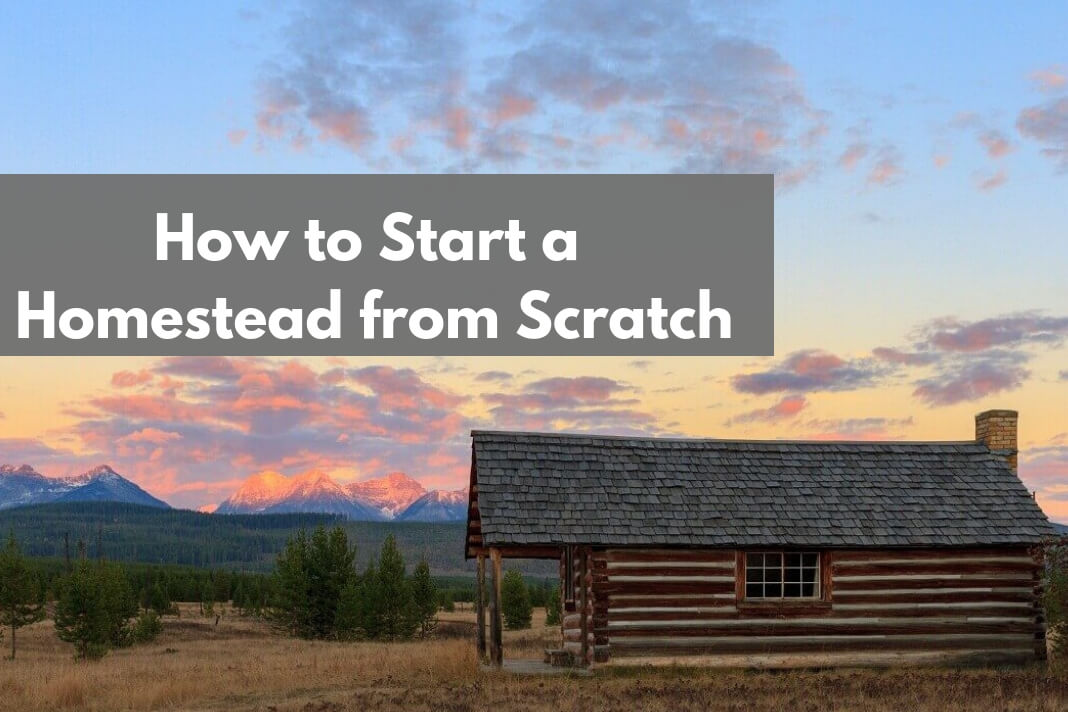
You can be a homesteader if you have land and related resources. Many homesteaders create a self-sustaining environment and at times even welcome tourists to earn extra income. The reason for homesteading varies from individual to individual. Some begin homestead for cost, while others choose this for a healthy lifestyle. Only you can tell your reasons. However, in this article, we will help you with the necessary information needed to start a homestead.
What is Homesteading
Are you up for homesteading?
If you are looking for rural living, away from the hustle bustle of the city life, and lead a simpler and more sustainable lifestyle, you could choose to be a homesteader. Every year many people switch to living as a homesteader. Homestead is a place where you can combine nature and necessity, and live. Clean air, less pollution, waking up to the sound of tranquility, and sparkling, fresh and organic food are some of the perks of this lifestyle.
The most common misconception about homesteading is you need to have a huge piece of land. But it is not true. Homesteading is not farming and vice-versa.
Homestead is a family house, where families live, cultivate their own food, and stay there self-sufficiently. On the other hand, the farm is land cultivated for agricultural purpose. Farms are lands prepared for breeding and raising cattle or aquatic animals.
There are other major differences between the two. And, you must know them to make the right decisions.
Who is a Homesteader
If your only purpose is to earn money by cultivating crops and cattle, homesteading is not for you.
A homesteader is a person or a family who cultivates land and strives to live off the land by growing and raising what he needs and eats. Selling off their land cultivation is not the primary goal of a homesteader, although he can often sell what he grows. Homesteaders like to use what they can on their land to make their living more sustainable. They believe in organic products and eat what they grow. Homesteads can be referred to as farmhouses with adjacent lands and buildings. One must start homesteading under the Homestead Act. If you decide to become a one, try not to get too much caught up in the lifestyle; instead, think of the numerous ways to earn money from a homestead.
Who is a Farmer
A farmer’s single goal is to produce and cultivate crops and cattle and raise money by selling them. He not only strives to make a living but generate a good income simultaneously. Their lands are usually bigger in size than that of homesteaders’. They hire people to cultivate and buy equipment to modernize their business. Most farmers are conventional, while there are few who believe in a sustainable life.
While farming is a business, homesteading is a lifestyle.
Advantages of Homesteading
Homesteading brings several advantages, to both you and your property. In many states, homesteaders can take advantage of the homestead exemption. Homestead exemption allows the owner to protect the value of the property from property taxes and creditors.
- Property Taxes: The owner can shield a portion of a home’s value from taxes. Basically, a certain part of the homestead could be tax exempted. Typically, the first $25,000 to $75,000 of the asset value is exempted from all property taxes. This means you will only owe property taxes on the remaining value of the asset.
- Forced Sale: You no longer have to force-sale your homestead to satisfy creditors. For instance, the financer of your automobile cannot seize or force-sale your homestead if you waver from your auto loan payment. However, in case of mortgage disclosures and defaulted property taxes, your home will not be shielded from forced sale under homestead exemption.
- Surviving Spouses: Surviving spouses under the homestead law retain the rights to homestead even after the death of their spouses. As long as they live there, they won’t lose property However, in order to retain the right, the surviving spouse must make sure mortgage and other payment dues are cleared.
Apart from the exemption benefits, other advantages of owning a homestead include:
- Homestead is a less stressful way of living, in comparison to an urban The study shows it has a significant effect on stress levels, anxiety, depression, and tension.
- Cultivating, growing, and providing to your family is a great pride. You get to learn a lot of things from doing stuff on your own.
- It is a secure way of living and it brings families closer. Homesteading is a great way of bonding.
- Since homesteaders do all the work by themselves, the physical activity, combined with freshly grown organic food aid in better physical and mental health.
- You get to learn new skills, right from growing vegetables, cultivating crops, raising livestock, plumbing, drilling, grinding, and of course, Living with nature is the best way of living.
Of course, there are drawbacks. For instance, you have to do all of the everyday chores by yourself. You won’t get necessary supplies, provisions, food, medicines, and other professional help quickly. You will have to plan your trips to the city and buy everything you need at one go. Since you will be completely disconnected from the urban life, you may miss out on the latest trends and news on different subjects.
Starting a homestead is not that easy, especially if you are prepared for the challenges it brings. If you are too comfortable in living an urban lifestyle, getting accustomed to an almost -farmer’s life could be taxing and overwhelming.
Steps to Start a Homestead
Step 1: Plan the Process
You have to decide what your long-term goals are, and weigh the idea of homesteading from all angles. Do not rush into this. This is a lifestyle change. So be cautious and sure. You must also decide the size of the land you would want to buy. You must also learn the fundamentals of homesteading. And the best place to learn is by talking to homesteaders. You must consider a lot of things before you start a self-sustainable lifestyle and live off the grid including:
- Look for renewable energy methods, such as building your own solar panels, having wind turbines for electricity, harvesting wood from your property, and alternative fuel sources, such as biodiesel and ethanol.
- Homesteading is all about growing your own vegetables and crop and feeding your family. And, a large part of growing crops involves buying fertilizers. Therefore, you must think of creating organic fertilizers on your own instead of spending on store brought ones.
Cows’ manure is a rich fertilizer. Other alternatives include creating a compost pile, worm farming, and mulching leaves and grasses.
- Winterize your home so that you need not to plan for heaters and waste a good deal of energy. Winterizing your home will keep you warm throughout your winter days.
- Petting a dog is a must for homesteaders, especially if your homestead is located in a remote place. Dogs are wonderful companions and great security guards for both your family and cattle. However, please adopt a dog that is powerful and can be trained to guard the homestead.
Step 2: Start Your Garden
You just have to make an initial investment in seeds and reap benefits from the harvest throughout a season. You will essentially cut down the cost of goods that you buy from stores. Fresh veggies are best as they are packed with nutrition and are less contaminated. Good news is you can sell the surplus to nearby houses. Some tips for planting gardens include:
- Learn how to plant crops. Learn about different soils, watering, drainage, harvesting, fertilizing Crop rotation is an important element in gardening, especially if you decide to plant crops in large quantities.
- Grow fruits and vegetables that ripen at different times of the year so that you have provisions all year around. This way, harvesting also gets easier.
- Don’t forget to plant a herb garden. Herbs are essential ingredients of the meal making process. So, you must make this smart choice. The good part is you can dry the herbs and store them for the entire year.
Step 2: Think about Building a Chicken Coop
Chickens are easy to grow and an important farm animal. So, before raising the stock, build a chicken coop to house the easily wandering birds. Your chicken coop must be spacious so that chickens can roam around, nest, and lay eggs conveniently.
Second best farm animals next to chickens are rabbits. They are easy to raise for they eat greens and veggies only. They are very easy to take care of. So build a hutch for the rabbits. Also, consider having ducks. However, you will have to invest in a small pond in which your ducks can paddle and nest.
Many homesteaders claim that chicken and rabbit manures are great together for fertilization, as one is hot and the other is cold.
Step 3: Raise Cows
Although it is not compulsory, raising cows can bring endless benefits to the homesteader. The first benefit is that your family will consume fresh and unadulterated milk and freshly made dairy products, such as cottage cheese, curd, cheese, butter, and ghee every day.
Your other animals will also become healthy and sturdy by consuming the milk byproducts, such as whey. Lastly, cows manure is one of the best fertilizers, which you will get in abundance. In India, cows’ manure and urine are traditionally used as organic pesticides and home cleaners. So, if one animal can give you so many benefits, you should consider raising them.
However, you must have the required land to correctly raise and maintain a cow. You must have a minimum land area of one acre. And, if you have the needed land, you could think of raising both milking cows and meat cows.
Step 4: Start Beekeeping
You can farm honeybees easily as it does not demand a lot of space. Honeybees are pretty clean, and quite easy to pet – they catch their own food, they clean themselves, they do not need watchdogs, and they even build their hives. And, what are the benefits? Well, you get to have your own honey. You can sell them too. You can also use the beeswax to make crafts and sell them. You can also ferment and brew beeswax to make mead.
Step 5: Consider Raising Pigs, Buffalos, Goats
Goats and buffalos are excellent substitutes for the cow, for their milk can also supplement cow milk and can be used to produce dairy products. Pigs are also excellent livestock. Their meat could be sold, they can be used for plowing, and their manure can be used for making fertilizers.
Step 6: Learn to Can Fresh Produce Properly
Although seasonal fruits &veggies and fresh food are best for diet and nutrition, you can preserve most of the veggies and fruits if you end up having a surplus. Use a pressure canner if you plan to preserve a lot of food during scarcity. Pressure canning makes the entire process easier and efficient. Pickling foods is another way to preserve foods for later use, especially in the winter when we do not get vegetables at all. Learn how to pickle foods. They make a great side for dishes and meals.
Step 7: Learn How to Make Dairy Products
Homesteading is all about cultivating and producing your own goods. Therefore, you must learn to make milk into dairy products. You can make butter, cheese, ice-cream, yogurt, and ghee out of milk. They are pretty easy to make if you master the technique.
Step 8: Learn Additional Skills Needed for Homesteading
You must learn a lot of job works to build and maintain your homestead. Some of the important skills you must learn are:
- How to use hammers, screwdrivers, saw, ax, and other tools from the box
- How to sew and mend clothes
- How to make soaps, candles, and other homemade products from basic household stuff
- How to reuse or recycle supplies
- Learn basic plumbing and electrical work
- Learn basic carpentry
This article will act as a guide to get everything started. Adjust the steps to fit your goals. For further information, message us on comments below.




